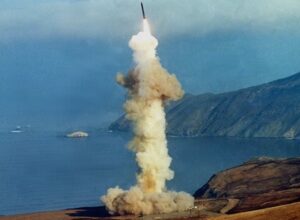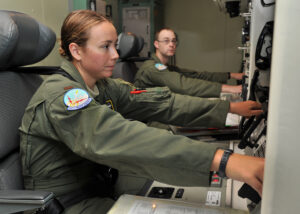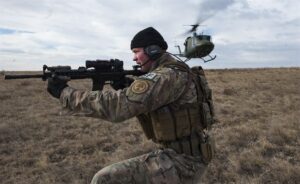 Many Americans are asking whether the three legs of the nuclear triad are still relevant. My answer to this question is an emphatic, yes. Today’s discussion should not be about “if” we recapitalize the triad, but instead how to enhance the execution of the strategic deterrence mission.
Many Americans are asking whether the three legs of the nuclear triad are still relevant. My answer to this question is an emphatic, yes. Today’s discussion should not be about “if” we recapitalize the triad, but instead how to enhance the execution of the strategic deterrence mission.
Since the end of the 1950s, the United States has maintained the triad of nuclear weapon delivery systems: strategic bombers, InterContinental Ballistic Missiles (ICBMs), and Submarine-Launched Ballistic Missiles (SLBMs). Although administrations of both parties have adjusted the triad’s forces, its size, its base locations, and other details, all presidents, with the support of Congress, have maintained the nation’s fundamental reliance on the triad, believing it to offer a diverse and powerful set of options to deter adversaries from aggression and to assure allies.

Roger Burg
Let us examine the land-based leg of the triad—ICBMs, a field I have been involved with deeply for decades of my Air Force career. They provide a range of crucial capabilities that underwrite nuclear stability and deterrence. More directly, these weapons raise the deterrent stakes the highest, for they are located in the heart of sovereign US territory. While bombers and submarines are potent and highly capable, an adversary could strike one of these assets when deployed and it remains debatable how the US would respond.
An aircraft shot down or a ship lost at sea is a terrible event, but the US has accepted such losses before in crisis, and not gone to war. This ambiguity is totally removed when evaluating a strike within our country. ICBMs are based in Wyoming, Montana, Nebraska, North Dakota, and Colorado. Even if submarines and bombers could be detected and defeated, an adversary would still have to attack missile silos in all of those states to ensure the US would not launch a retaliatory strike. Bluntly, an attack of that scale and scope portends a massive commitment of both will and capability.
However, our current ICBM capability will not last indefinitely. The current force of Minuteman III ICBMs, procured in the 1970s and recapitalized in the late 1990s, is aging and must be replaced by 2030. While this will prove costly, failing to do so will see America cede a critical capability that kept the peace during the darkest days of the Cold War and beyond. Recapitalization also presents the nation an opportunity to enhance the force with significant advances to vastly improve nuclear weapons security and surety.
 For example, the current Minuteman ICBM weapon system was originally deployed at Malmstrom AFB, MT., Minot AFB, ND., and F.E. Warren AFB, WY. between 1961 and 1965. Although the missile and the launch control system were modernized several times, much of the original infrastructure and design of security operations remain in place. In the mid-1990s the Air Force identified a need to upgrade security features to protect against more modern threats, and invested in a variety of improvements—hardware, surveillance, security equipment, and improved tactics and procedures for protecting ICBM installations. These improvements remain in use and are well maintained, but they are still based on original technology available at the time these upgrades were completed.
For example, the current Minuteman ICBM weapon system was originally deployed at Malmstrom AFB, MT., Minot AFB, ND., and F.E. Warren AFB, WY. between 1961 and 1965. Although the missile and the launch control system were modernized several times, much of the original infrastructure and design of security operations remain in place. In the mid-1990s the Air Force identified a need to upgrade security features to protect against more modern threats, and invested in a variety of improvements—hardware, surveillance, security equipment, and improved tactics and procedures for protecting ICBM installations. These improvements remain in use and are well maintained, but they are still based on original technology available at the time these upgrades were completed.
As the Air Force looks at new, more efficient, and more effective ways of conducting operations in ICBM fields, a comprehensive modernization of the infrastructure supporting the ICBM weapon system offers a long-term payback via the use of modern surveillance, situational awareness, and command and control concepts to provide significant advances for security of the ICBM weapon system in storage, in transit during maintenance, and during its hardened, deployed, “on alert” configuration. Concepts such as vaulted entry to the launch facility, hardened transport vehicles, advanced surveillance for both alert status and during transit movements of ICBMs offer the potential for a safer, more secure, and far more effective and efficient operation of the ICBM weapon system. Also, upgrading the security systems and concepts will allow a far more efficient use of limited manpower for security activities and for maintenance.
In addition, with the Air Force expected pursue a full modernization effort in the Ground Based Strategic Deterrent (GBSD) program, the service can take advantage of the opportunity to significantly improve nuclear surety features within the ICBM weapon system. Whether in storage, in transit, or in its deployed operational configuration, the highest levels of nuclear surety are essential to maintain confidence that accidents, incidents, and malfunctions within the nuclear weapon system will never lead to a nuclear yield or radioactive release.
 It does not take a great deal of imagination to see the potential for using advances in computers, communications, miniaturization, robotics, advanced materials and other areas to create potentially great advantages for a modernized nuclear force, including advances in the weapons systems and the deployment modes. For instance, modernized ICBMs could take advantage of advances in communications to add redundancy and resiliency, advances in design of facilities and vehicles to improve nuclear weapons security and nuclear surety, and also to decrease the manpower needed to operate, maintain, and secure the nuclear force for decades into the future.
It does not take a great deal of imagination to see the potential for using advances in computers, communications, miniaturization, robotics, advanced materials and other areas to create potentially great advantages for a modernized nuclear force, including advances in the weapons systems and the deployment modes. For instance, modernized ICBMs could take advantage of advances in communications to add redundancy and resiliency, advances in design of facilities and vehicles to improve nuclear weapons security and nuclear surety, and also to decrease the manpower needed to operate, maintain, and secure the nuclear force for decades into the future.
The ICBM remains the backbone of the US nuclear deterrent, and the triad concept remains the foundation of a strategic force that deters adversaries, while assuring allies. Proposals to reduce or eliminate the country’s ICBM force disregard these weapons’ many unique contributions to national defense that other capabilities cannot duplicate.
To answer these critiques, the Mitchell Institute for Aerospace Studies has released a major study that articulates and advances two important and interlinked arguments. First, the land-based leg of the triad provides a range of crucial capabilities that underwrite our national deterrence capabilities and are even more vital in the 21st century; and second, ICBM recapitalization must proceed without delay, as the existing inventory could catalyze reliability problems in the next decade if unaddressed. If critics think modernizing the strategic deterrent enterprise is expensive today, failing to do so will prove far costlier in the starkest terms.
The increasingly unstable global security environment calls for the United State’s leaders to have the most flexible and capable nuclear deterrent force possible, which the nation cannot have without a modern ICBM force. Extensive nuclear modernization programs under way by potential adversary nations require US recapitalization to avoid a serious erosion of American nuclear deterrent capability. Failing to invest in a recapitalization of the nuclear deterrent, especially in the ICBM force, will merely clear a path to obsolescence and eventual dissolution.
Roger Burg, who retired from the Air Force in 2010 after 32 years on active duty, held numerous leadership positions in ICBM and space units, to include command at the squadron, group, wing and numbered air force levels. His final job was as commander of 20th Air Force, F.E. Warren AFB, Wyoming, where he was responsible for 10,000 airmen, three operational bases and 500 deployed ICBMs.
Connecticut lawmakers to grill Army, Lockheed about job cuts at Sikorsky helicopter unit
“The Connecticut delegation has questions about why, with that [FY24] appropriation in hand, this happened,” said Rep. Joe Courtney, D-Conn.


























